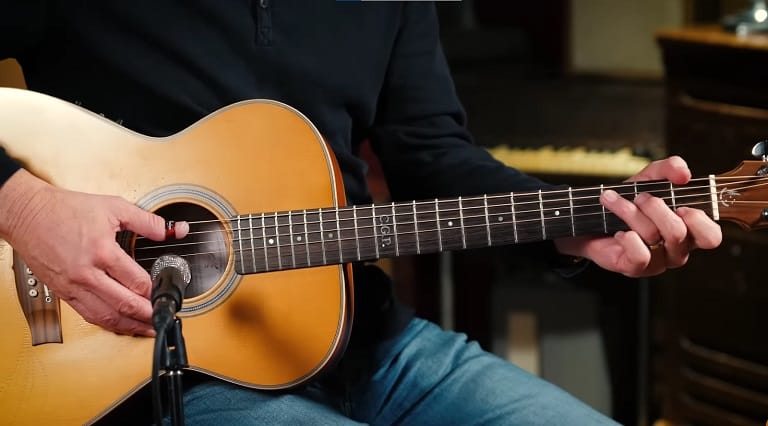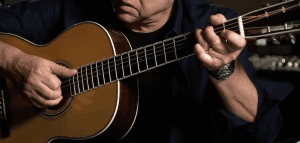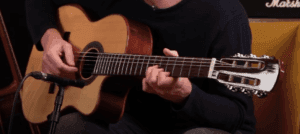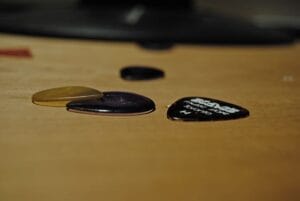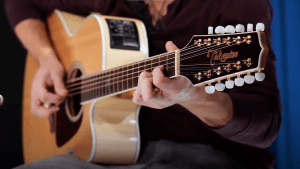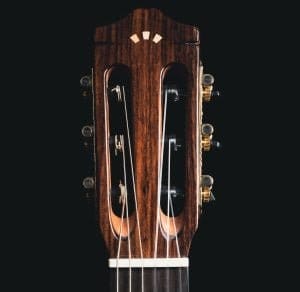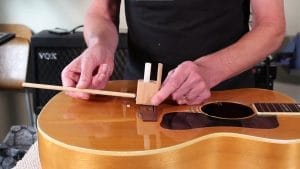Table of Contents
In the world of music, fingerstyle guitar is a technique loved and used by many. It involves plucking the guitar strings with your fingers rather than a pick, resulting in a completely different approach to the instrument.
I’m sure you’re here because its beauty has already enamored you. Each finger’s touch crafts a distinct note, and the guitar transforms into an instrument of expressive artistry. So, without further ado, let’s get familiar with fingerstyle guitar’s technical and creative aspects and how to start learning it. Check out other excellent classical guitar techniques you must know about.

The Essence Of Finger Style Guitar Explained
What is Fingerstyle Playing?
Fingerstyle guitar is a captivating technique where a guitarist uses their fingers, rather than a pick, to pluck the guitar strings. Please note that all guitar playing styles that include finger picking are not necessarily fingerstyle.
Guitar players like Mark Knopfler and John Mayer pluck with their fingers but are not fingerstyle guitarists. Fingerstyle is a style of fingerpicking that largely focuses on playing the melody and accompaniments of a song, all with one guitar.
This approach allows for a more nuanced and expressive range of tones and textures, making it a favorite among acoustic guitar players.
Typically, fingerstyle guitarists use their picking hand’s thumb, index, middle, and ring fingers to pluck the strings individually. Each finger is assigned to specific strings, and this fingerpicking pattern can vary depending on the guitarist’s style and preferences.
Reasons To Learn The Fingerstyle
One of the distinctive features of fingerstyle guitar is its ability to combine melody, harmony, and rhythm simultaneously. A pick user cannot simultaneously play notes on multiple strings unless the strings are adjacent.
Fingerpicking enables players to pluck two to four strings simultaneously and sustain notes of varying lengths. This technique enables the guitarist to create intricate and harmonically rich arrangements that can be both soothing and virtuosic.
This is especially suitable for players looking to play classical pieces where the music is divided into two parallel melodies in the upper and lower registers. Finger-style guitar makes it possible to play a bassline on the thick strings and a leading melody on the thin strings parallelly, so adopting classical pieces becomes possible.
Players who prefer being solo performers also take up on it, as finger stylists can get by without accompanying harmony or rhythm players.
Learning The Finger Style Guitar
The initial steps for learning can be sequenced as follows:
Hand Positioning
Unlike pick users, fingerstyle players must keep the right hand in a fixed position over the strings. Place it over the sound hole for the most resonance. Keep your thumb straight, hovering over the bass strings. Other fingers should make a loose 90 degrees with the palm at the first joint, pointed towards their assigned string.

Finger Assignment
The right-hand finger assignment for guitar strings is shown as follows.
| Finger (English) | Finger (Spanish) | Abbreviation | String plucked |
| Thumb | Pulgar | P | 6th, 5th, 4th |
| Index | Indice | I | 3rd |
| Middle | Medio | M | 2nd |
| Ring | Annular | A | 1st |
The thumb plays the bass strings, the only finger assigned to multiple strings. Remember not to bend the finger joint near the tip of your finger too much. Pluck by moving your fingertips along the direction of the surface of the guitar body, not perpendicular to it.
Developing Hand Coordination
Coordination between the fingers of the left and right hand is vital to fingerstyle guitar. First, you should get used to plucking the strings using the previously shown finger assignment with the right hand. Try patterns that go like this:
Pattern 1
| Beat | 1 | 2 | 3 | 4 | 5 | 6 |
| String | 6 | 5 | 4 | 3 | 2 | 1 |
| Fret | 0 | 0 | 0 | 0 | 0 | 0 |
| Finger | P | P | P | I | M | A |
Do the same but backward. Keep doing this back and forth until it sounds steady and clean.
Pattern 2
| Beat | 1 | 2 | 3 | 4 | 5 | 6 | 7 | 8 |
| String | 6 | 5 | 4 | 3 | 1 | 2 | 3 | 4 |
| Fret | 0 | 0 | 0 | 0 | 0 | 0 | 0 | 0 |
| Finger | P | P | P | I | A | M | A | I |
Once your right hand is used to the playstyle, try doing linear chromatic runs like 1-2-3-4 frets in each string using appropriate right-hand fingerpicking. An example would look like this.
| Beat | 1 | 2 | 3 | 4 | 5 | 6 | 7 | 8 |
| String | 6 | 6 | 6 | 6 | 1 | 1 | 1 | 1 |
| Fret | 1 | 2 | 3 | 4 | 1 | 2 | 3 | 4 |
| Finger | P | P | P | P | A | A | A | A |
Do it in both ascending and descending order in all strings.
Learning To Arpeggiate
The next level in learning hand coordination is playing arpeggios. This is done by holding down chord shapes with your left hand and plucking the strings using the right, the picking hand, in various patterns. The notes are sustained throughout each bar.
Arpeggios are the essence of the fingerstyle guitar. The multitude of chord voicings and progressions possible make this an endless journey. You can play most of the songs out there if you have the essential open chords and some common right-hand fingerpicking patterns.
Easy fingerstyle songs to learn
There are countless songs based on simple arpeggiated chord progressions that you can learn in fingerstyle. Some off the top of my head:
- Don’t Cry – Guns N’ Roses
- The Sound of Silence – Simon & Garfunkel
- Nothing else matters – Metallica
- Tears in Heaven – Eric Clapton
- Never Let Go – Camel
- Dust in the Wind – Kansas
- Hope Leaves – Opeth
- Moonlight Sonata Movement 1 – Beethoven
- Bouree in Em – J.S. Bach
What’s next?
There are many intermediate and advanced finger-style guitar techniques you can learn. Incorporating linear melodies in arpeggios, arpeggiating with a moving bassline, percussive thumb slaps, various legato techniques, tremolo, and Travis picking. The list goes on and on. Pick your poison, down it, and pluck your heart out!
FAQ
Compared to using a pick, yes. Plucking with fingers requires more coordination in general.
It’s not mandatory, but many prefer growing their nails for fingerstyle playing because it offers a more defined tone than notes plucked by fingertips.
You can. In that case, you’ll have to build left-hand strength and mobility alongside the steps mentioned in the article.
Steel string guitars are the standard for beginners as learning on them helps develop the most finger strength. But classical guitars, with their wider fretboards and softer strings are also a great option.
- 6 Unique Guitar Picks That Will Blow Your Mind - February 6, 2025
- Master the Harmonic Major Scale And Intervals - February 6, 2025
- 9 Eye Catchy Unique Guitar Straps for Every Musician - February 6, 2025

